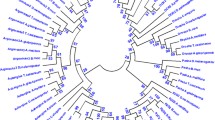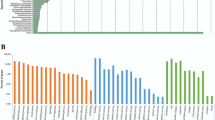Abstract
RNA interference (RNAi)-mediated knockdown serves as an effective technique for the functional analysis of developmental genes that is well established in many organisms. In the beetle Tribolium castaneum, double-stranded RNA is applied by simple injection and distributes systemically within the tissue. Thus, systematic testing for RNAi specificity and efficiency is easily possible in this organism. Generally, the use of non-overlapping dsRNA fragments yielding qualitatively identical phenotypes is the method of choice to verify target-specific knockdown effects. Here, we show that UTR-specific RNAi results in different effects regarding quality, severity and penetrance when compared to RNAi fragments directed at the coding region. Furthermore, when using 3′UTR-specific dsRNA, we first describe the Distal-lessRNAi antenna-to-leg transformation phenotype in the Tribolium larva, which has only been observed in the adult beetle and Drosophila so far. In addition, we unexpectedly observed sterility effects caused by 3′UTR-specific knockdown of the Tribolium-Sp8 orthologue that is not seen when dsRNA targeted a sequence within the coding-region or the 5′UTR that itself led to early embryonic lethality. We conclude that targeting UTR sequences by region-specific RNAi can reveal unexpected new aspects of gene function applicable in basic research and crop protection.




Similar content being viewed by others
References
Bartel DP (2009) MicroRNAs: target recognition and regulatory functions. Cell 136:215–233. https://doi.org/10.1016/j.cell.2009.01.002
Beermann A, Jay DG, Beeman RW, Hülskamp M, Tautz D, Jürgens G (2001) The Short antennae gene of Tribolium is required for limb development and encodes the orthologue of the Drosophila Distal-less protein. Development 128:287–297
Beermann A, Aranda M, Schröder R (2004) The Sp8 zinc-finger transcription factor is involved in allometric growth of the limbs in the beetle Tribolium castaneum. Development 131:733–742. https://doi.org/10.1242/dev.00974
Brown SJ, Shippy TD, Miller S, Bolognesi R, Beeman RW, Lorenzen MD, Bucher G, Wimmer EA, Klingler M (2009) The red flour beetle, Tribolium castaneum (Coleoptera): a model for studies of development and pest biology. Cold Spring Harbor Protocols 2009:pdb.emo126-pdb.emo126 https://doi.org/10.1101/pdb.emo126
Bucher G, Scholten J, Klingler M (2002) Parental RNAi in Tribolium (Coleoptera). Curr Biol 12:R85–R86
Chan CY, Carmack CS, Long DD, Maliyekkel A, Shao Y, Roninson IB, Ding Y (2009) A structural interpretation of the effect of GC-content on efficiency of RNA interference. BMC Bioinformatics 10(Suppl 1):S33. https://doi.org/10.1186/1471-2105-10-S1-S33
Cohen SM, Jürgens G (1989) Proximal distal pattern-formation in Drosophila - cell autonomous requirement for Distal-less gene activity in limb development. Embo J 8:2045–2055
Cohen SM, Brönner G, Küttner F, Jürgens G, Jäckle H (1989) Distal-less encodes a homoeodomain protein required for limb development in Drosophila. Nature 338:432–434. https://doi.org/10.1038/338432a0
Ding SW (2010) RNA-based antiviral immunity. Nat Rev Immunol 10:632–644. https://doi.org/10.1038/nri2824
Dong PD, Chu J, Panganiban G (2000) Coexpression of the homeobox genes Distal-less and homothorax determines Drosophila antennal identity. Development 127:209–216
Dong PD, Chu J, Panganiban G (2001) Proximodistal domain specification and interactions in developing Drosophila appendages. Development 128:2365–2372
Fire A, Xu S, Montgomery MK, Kostas SA, Driver SE, Mello CC (1998) Potent and specific genetic interference by double-stranded RNA in Caenorhabditis elegans. Nature 391:806–811. https://doi.org/10.1038/35888
Henschel A, Buchholz F, Habermann B (2004) DEQOR: a web-based tool for the design and quality control of siRNAs. Nucleic Acids Res 32:W113–W120. https://doi.org/10.1093/nar/gkh408
Holen T, Amarzguioui M, Wiiger MT, Babaie E, Prydz H (2002) Positional effects of short interfering RNAs targeting the human coagulation trigger tissue factor. Nucleic Acids Res 30:1757–1766
Joga MR, Zotti MJ, Smagghe G, Christiaens O (2016) RNAi efficiency, systemic properties, and novel delivery methods for pest insect control: what we know so far. Front Physiol 7:553. https://doi.org/10.3389/fphys.2016.00553
Kitzmann P, Schwirz J, Schmitt-Engel C, Bucher G (2013) RNAi phenotypes are influenced by the genetic background of the injected strain. BMC Genomics 14:5. https://doi.org/10.1186/1471-2164-14-5
Mamta B, Rajam MV (2017) RNAi technology: a new platform for crop pest control. Physiol Mol Biol Plants 23:487–501. https://doi.org/10.1007/s12298-017-0443-x
Napoli C, Lemieux C, Jorgensen R (1990) Introduction of a chimeric chalcone synthase gene into Petunia results in reversible co-suppression of homologous genes in trans. Plant Cell 2:279–289. https://doi.org/10.1105/tpc.2.4.279
Panganiban G (2000) Distal-less function during Drosophila appendage and sense organ development. Dev Dyn 218:554–562. https://doi.org/10.1002/1097-0177(200008)218:4<554::AID-DVDY1023>3.0.CO;2-#
Sarrazin AF, Peel AD, Averof M (2012) A segmentation clock with two-segment periodicity in insects. Science 336:338–341. https://doi.org/10.1126/science.1218256
Schmitt-Engel C, Schultheis D, Schwirz J, Ströhlein N, Troelenberg N, Majumdar U, Dao VA, Grossmann D, Richter T, Tech M, Dönitz J, Gerischer L, Theis M, Schild I, Trauner J, Koniszewski NDB, Küster E, Kittelmann S, Hu Y, Lehmann S, Siemanowski J, Ulrich J, Panfilio KA, Schröder R, Morgenstern B, Stanke M, Buchhholz F, Frasch M, Roth S, Wimmer EA, Schoppmeier M, Klingler M, Bucher G (2015) The iBeetle large-scale RNAi screen reveals gene functions for insect development and physiology. Nat Commun 6:7822. https://doi.org/10.1038/ncomms8822
Scott JG, Michel K, Bartholomay LC, Siegfried BD, Hunter WB, Smagghe G, Zhu KY, Douglas AE (2013) Towards the elements of successful insect RNAi. J Insect Physiol 59:1212. https://doi.org/10.1016/j.jinsphys.2013.08.014
Shukla GC, Singh J, Barik S (2011) MicroRNAs: processing, maturation, target recognition and regulatory functions. Mol Cell Pharmacol 3:83–92
Sigoillot FD, King RW (2011) Vigilance and validation: keys to success in RNAi screening ACS. Chem Biol 6:47–60. https://doi.org/10.1021/cb100358f
Smith FW, Angelini DR, Jockusch EL (2014) A functional genetic analysis in flour beetles (Tenebrionidae) reveals an antennal identity specification mechanism active during metamorphosis in Holometabola. Mech Dev 132:13–27. https://doi.org/10.1016/j.mod.2014.02.002
Sunkel CE, Whittle JR (1987) Brista: a gene involved in the specification and differentiation of distal cephalic and thoracic structures in Drosophila melanogaster. Roux Arch Dev Biol 196:124–132. https://doi.org/10.1007/BF00402034
Suzuki Y, Squires DC, Riddiford LM (2009) Larval leg integrity is maintained by Distal-less and is required for proper timing of metamorphosis in the flour beetle, Tribolium castaneum. Dev Biol 326:60–67. https://doi.org/10.1016/j.ydbio.2008.10.022
Thümecke S, Beermann A, Klingler M, Schröder R (2017) The flipflop orphan genes are required for limb bud eversion in the Tribolium embryo. Front Zool 14:48. https://doi.org/10.1186/s12983-017-0234-9
Tomoyasu Y, Miller SC, Tomita S, Schoppmeier M, Grossmann D, Bucher G (2008) Exploring systemic RNA interference in insects: a genome-wide survey for RNAi genes in Tribolium. Genome Biol 9:R10. https://doi.org/10.1186/gb-2008-9-1-r10
Wang W, Wan P, Lai F, Zhu T, Fu Q (2018) dsRNA targeting calmodulin reveal a potential target for pest management of Nilaparvata lugens. Pest Manag Sci. https://doi.org/10.1002/ps.4865
Yoshinari K, Miyagishi M, Taira K (2004) Effects on RNAi of the tight structure, sequence and position of the targeted region. Nucleic Acids Res 32:691–699. https://doi.org/10.1093/nar/gkh221
Zotti M, Dos Santos EA, Cagliari D, Christiaens O, Taning CNT, Smagghe G (2017) RNAi technology in crop protection against arthropod pests, pathogens and nematodes. Pest Manag Sci. https://doi.org/10.1002/ps.4813
Acknowledgements
We thank Verena Hofer-Pretz for excellent technical assistance and beetle care and Dr. Anke Beermann for helpful comments throughout the work.
Authors’ contributions
ST performed all experiments; ST, RS planning work and writing manuscript.
Funding
German Research Community DFG; (Grant BE 4850/1-1).
Author information
Authors and Affiliations
Corresponding author
Ethics declarations
Competing interests
The authors declare that they have no competing interests.
Additional information
Communicated by Nico Posnien
Electronic supplementary material
Supplemental Figure 1
Tc-flipflop gene annotation, NOF positions & quantitative analyses. (A) Annotated genomic organisation of Tc-ff1 including non-overlapping fragments covering 5′UTR and coding region (NOF 1, 320 bp, GC-content 49.1%) and coding sequence and 3′UTR (NOF 2, 320 bp, GC-content 36.9%), respectively. (B) Annotation of the Tc-ff2 gene and non-overlapping fragments including 5′UTR and coding sequence (NOF 1) and coding sequence and 3’UTR (NOF 2), respectively. (C-D’) Quantitative analysis of Tc-ff1 and Tc-ff2 RNAi experiments displaying different results depending on the fragment used. Both Tc-ff1 (C) and Tc-ff2 (D) RNAi mainly result in the “empty egg” phenotype when the 5′-fragment (NOF 1) is used. (C’, D’) RNAi mediated knockdown using the 3′-fragment results displays a weaker phenotype resulting in analysable cuticles for both Tc-ff1 (C’) and Tc-ff2 (D’). (PDF 80 kb)
Supplemental Figure 2
Tc-flipflop RNAi: inverted appendages and empty eggs. (A) “Empty egg” phenotype. Most embryos did not reach the larval stage to develop a cuticle when the 5′-fragment (NOF 1) was used for both Tc-ff1 and Tc-ff2, respectively. (B-B’) Tc-flipflopRNAi phenotype displaying invaginated appendages. (B) Surface view: Out of the six thoracic legs five are not visible except for the most proximal segment (coxa, asterisks). (B’) Optical section displays invaginated legs (arrows) as well as an invaginated antenna (arrowhead). Ant antenna; Md mandible; T1 thoracic segment 1; scale bar 100 μm and; anterior to the left. (PDF 87 kb)
Supplemental Figure 3
Early lethality shown by live-imaging of Tc-Sp8RNAi embryos. (1–5) Live-imaging of an Tc-Sp8RNAi embryo after knockdown using a fragment against the 5′UTR (NOF1) over the course of 16.5 h. Tissue disintegration and clustering of cells after early blastoderm formation causes embryonic lethality and results in “empty eggs” as seen in Fig. 4A′. Scale bar 100 μm. (PDF 75 kb)
ESM 1
(DOCX 124 kb)
Rights and permissions
About this article
Cite this article
Thümecke, S., Schröder, R. UTR-specific knockdown of Distal-less and Sp8 leads to new phenotypic variants in the flour beetle Tribolium. Dev Genes Evol 228, 163–170 (2018). https://doi.org/10.1007/s00427-018-0614-y
Received:
Accepted:
Published:
Issue Date:
DOI: https://doi.org/10.1007/s00427-018-0614-y




